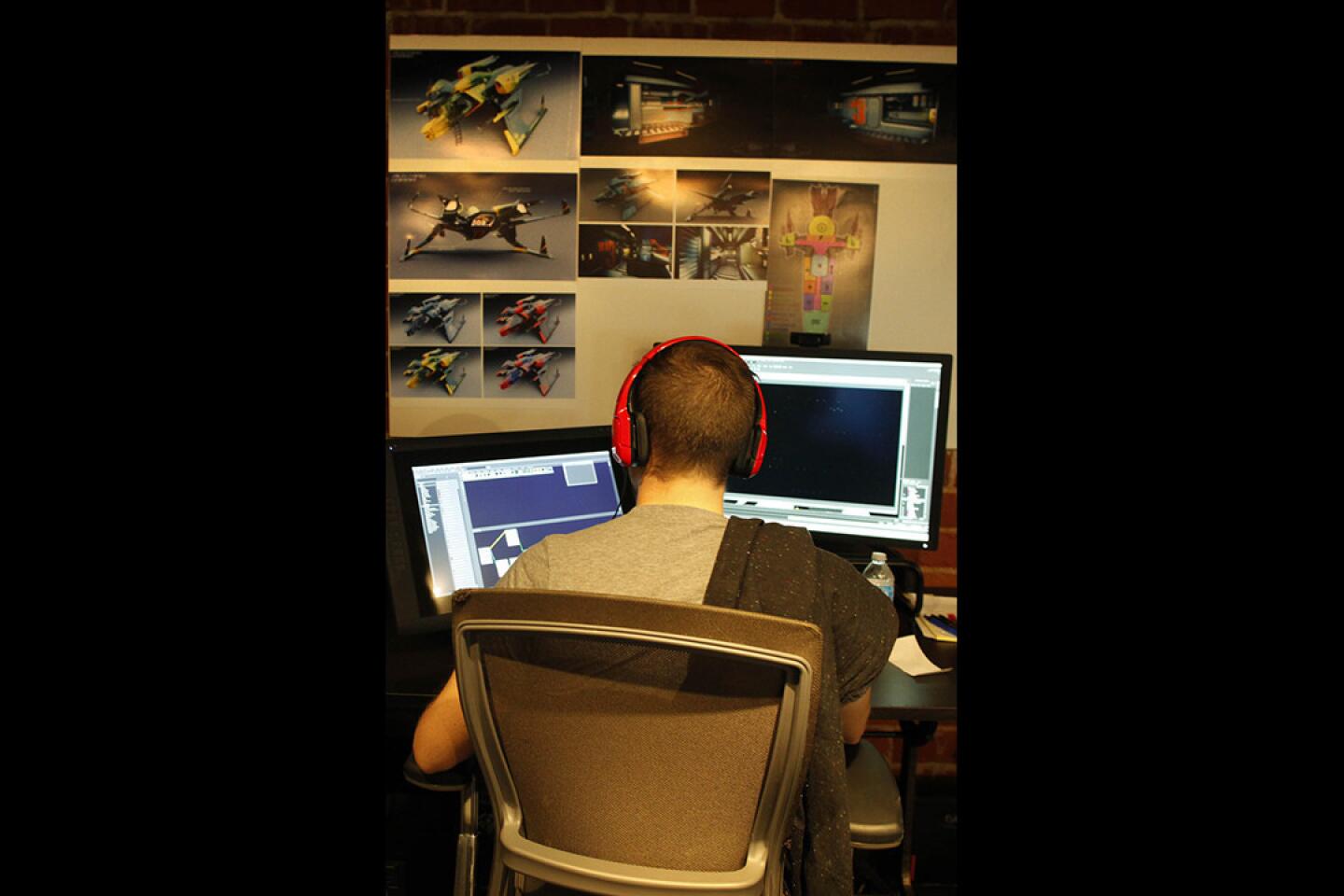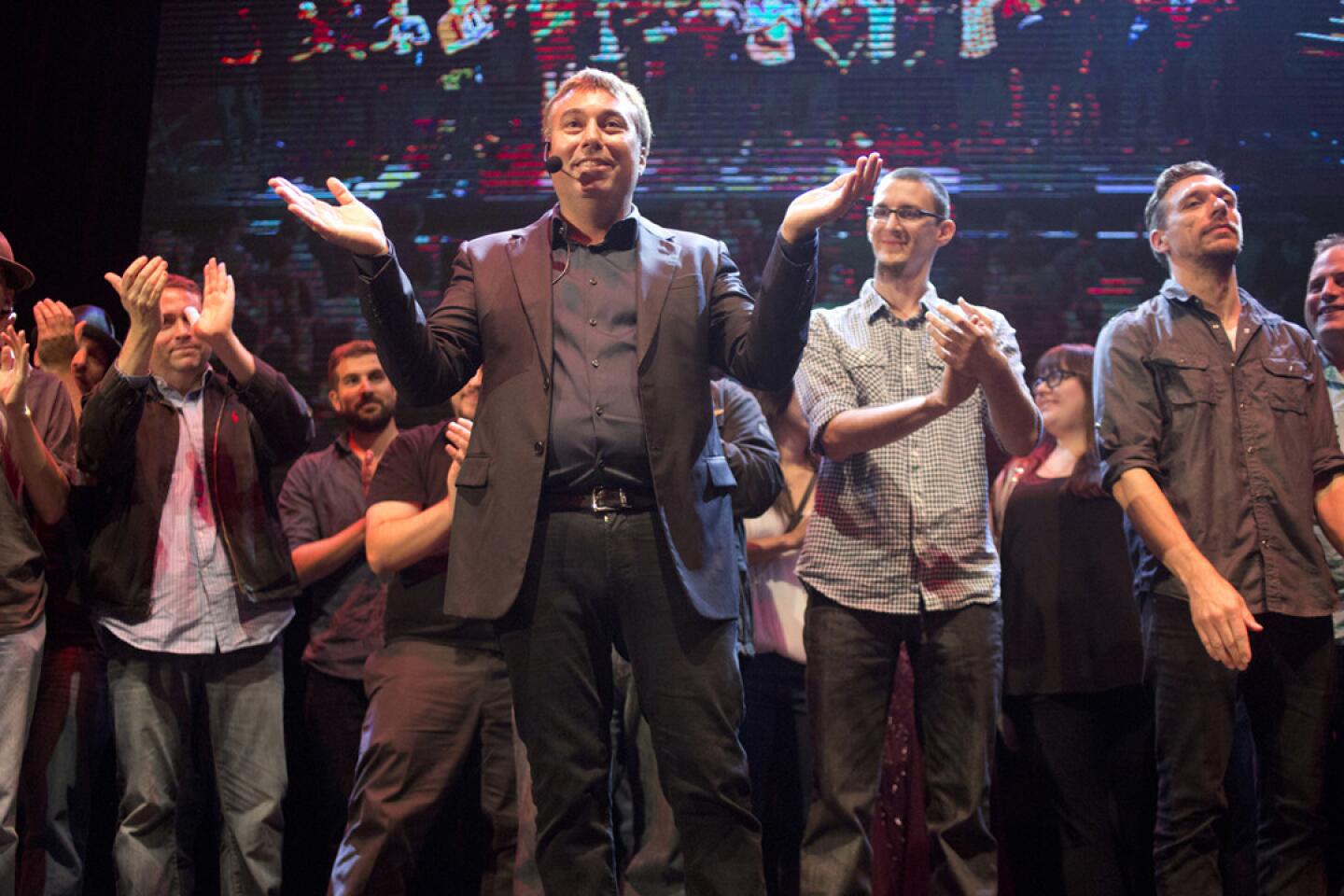Gamers’ funding fuels meteoric rise of ‘Star Citizen’
- Share via
Chris Roberts’ brain spun out a grand vision: a rich, immersive galaxy; exquisite spaceships traversing between infinite star systems with thousands of computer gamers manning the cockpits, racing, dogfighting and defending humanity.
He would call his game “Star Citizen.” It would be big. It would be ambitious. It would be ridiculously impressive. And it would be built outside the traditional publisher system dominated by big game companies such as Activision Blizzard and Electronic Arts.
The vision was clear. All he required was money.
Roberts — former Hollywood producer, movie director and veteran computer game creator — had a plan: raise several million dollars from true believers who would place advance orders. That would prove demand to venture capitalists, who could supply the tens of millions of dollars more that “Star Citizen” would require.
It turned out he didn’t need the venture capitalists.
More than $58 million has poured into the coffers of Roberts’ West Hollywood company, Cloud Imperium Games Corp., since “Star Citizen’s” inception two years ago. And cash continues to flow — nearly all of it raised from hard-core gamers who make pre-orders and spend cash on digital goods that range from one-man spaceships to interstellar caterpillars that look cool when they explode in space.
Small-scale video games have raised as much as a few million dollars through crowdfunding, a fundraising technique in which creators pitch ideas on the Web to attract relatively small amounts of cash from lots of people. But “Star Citizen” did something extraordinary: It quickly reached the several-million mark and then blew past it.
The result is a game industry phenomenon.
“Chris is demonstrating you can fund 100% development of a game if you have an audience that wants the game,” says Robin Kaminsky, entrepreneur-in-residence at venture capital firm Rustic Canyon Partners and former executive vice president at Activision. “We’ve never seen this for a game of this size.”
The full product isn’t scheduled for completion until sometime in 2016, but, according to Roberts, more than 600,000 fans worldwide are playing modules of the partly built game and suggesting improvements to developers. And they’re buying digital goods — an average of more than $90 per crowdfund contributor. Roberts attributes the success to the game’s possibility to last a lifetime.
“The idea is to make it a huge space playground that you dream of spending time in if you’ve ever watched ‘Star Wars,’” he said. “You can be a pilot, a mercenary, an explorer, a salvager; everything’s available to you.”
Cloud Imperium’s website features a live fundraising tracker and monthly progress reports on the accomplishments of its 280 employees and contractors, located in cities that include Santa Monica; Austin, Texas; Montreal; and Manchester, England.
The revealing look that Cloud Imperium offers into a typically secretive industry has invigorated people like Steve Snyder. The retired Air Force reconnaissance pilot wanted to keep flying as a hobby, but his wife said no. So the Orange County Fire Authority captain turned to computer games, resting his hands over a keyboard and joystick instead. Snyder, 57, came across a “Star Citizen” trailer on YouTube last January and got hooked.
He’s spent $1,500 on spaceships, including $300 this month to partner with a wingman to buy the 890 Jump, an exclusive space yacht whose “very presence signifies power,” according to Cloud Imperium. He’s also taking a more active role. Game designers consulted him to create real-looking firefighting outfits. And he volunteered to hand out pamphlets at this year’s annual Citizen Con, held this month at the Avalon Hollywood nightclub, where 300 fans gathered in the flesh, with 14,000 more watching a live Web feed.
“How many of us have dreamed of being astronauts at some point?” Snyder said. “This is the only way it’s going to happen these days for a lot of us, and I just wanted to make sure [Roberts] was successful.”
Roberts had set out to build “Star Citizen” like the popular games “Minecraft” and “League of Legends,” which slowly became more involved as they gained popularity across the world. But the ambition for “Star Citizen” quickly changed because of the fast cash. From the beginning, it was a cut above in visual appeal and scope, with highly detailed features, landscapes and characters that reflect a Hollywood gloss.
That’s probably because Roberts, 46, spent a decade in the movie business. He’s a native Californian who grew up in Manchester, England, doodling tanks as a child and programming games as a teenager. He started his career as a game designer, then formed Digital Anvil, a game company that developed the highly successful “Wing Commander” space combat video game franchise. In 1999, he turned the game into a feature-length movie as its director for 20th Century Fox. The film was a critical flop, though it scored high marks for special effects. Roberts continued in Los Angeles in the producer ranks on movies including “Lord of War,” starring Nicolas Cage, and “Who’s Your Caddy?”
He labored in Hollywood for a decade because he could astonish viewers with richness in detail and emotion that technology and low budgets prevented him from achieving in games.
By 2011, technology had “massively changed,” he said. Powerful graphics processors, computer chips and memory cards had become cheap enough for Roberts to deliver a game that drops people and their friends into an Internet-hosted universe where players by the thousands interact in a virtual reality.
Money remained an issue. Investors and publishers gravitate to games with wide appeal because sales can be astronomical. Wedbush Securities analyst Michael Pachter estimated Activision’s console title “Destiny,” a first-person shooter game released last month, sold 5 million copies in its first five days. War games sell well. Space games are niche — bought by maybe 1 million or 2 million during the life of the game, and dominated by established franchises, like Star Wars.
Roberts’ initial crowdfund pitch was aimed at three audiences: Fans of his old hit game, PC gamers whom he called “underserved” by developers, and people thrilled about exploring virtual worlds. With their support, he avoided the strings of big corporations and wealthy individuals.
The video game market is huge: $15.4 billion in U.S. sales alone in 2013, according to NPD Group. About half of that revenue comes from digital content like “Star Citizen,” downloaded on a computer, not bought in a store.
The revenue includes sales of virtual goods, a theoretically inexhaustible resource as long as fans keep buying. Cloud Imperium’s marketing budget includes large dollops spent on keeping the community engaged, holding live events, producing regular programs on YouTube and Twitch, and pumping out promotional videos that trumpet the latest spaceships on sale as if they were the newest must-have Mercedes-Benzes.
“The ability to create new content endlessly…. I think it shows how big it could possibly get,” Kaminsky said. “If people are willing to spend for stuff he hasn’t yet created, I wouldn’t be surprised by $100 million in crowdfunding.”
Dmitri Williams, head of analytics firm Ninja Metrics, said “Star Citizen” is drawing industry attention, though some wonder whether the project is a one-off exception made possible by a cult hero like Roberts.
“Is this an outlier or the new normal?” he said. “I think we have to take this kind of funding seriously, but we should also remember the novelty of the situation.”
But, he added, “the lesson to the broader gaming industry is that players matter. They vote with their feet, and now with their wallets — and if they have new ways to vote, they’ll use them. In a way, [Cloud Imperium is] reducing the noise that middlemen bring to the process.”
As for Roberts, he’s encouraged by the message “Star Citizen” is delivering to the gaming world that “talented kids who can inspire people’s imaginations” have fertile ground to challenge “the big guys.”
“Digital distribution has liberated a lot of people,” he said. “Maybe you won’t raise what we have, but small teams with good ideas can get them out there. It’s brighter out there than it’s been in quite some time.”
Twitter: @peard33
More to Read
Inside the business of entertainment
The Wide Shot brings you news, analysis and insights on everything from streaming wars to production — and what it all means for the future.
You may occasionally receive promotional content from the Los Angeles Times.















